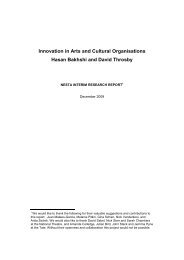Rumbling on performativity_Frits Simon
Rumbling on performativity_Frits Simon
Rumbling on performativity_Frits Simon
You also want an ePaper? Increase the reach of your titles
YUMPU automatically turns print PDFs into web optimized ePapers that Google loves.
Theories of change have built up mass, of which the rich diversificati<strong>on</strong> in perspectives<br />
is an eye-catching feature. At the same time the effectiveness is debated, leading<br />
am<strong>on</strong>gst others to an appeal for evidence based practices (Cozijnsen, 2013; S<strong>on</strong>naville,<br />
2005).<br />
Legitimacy of the adviser<br />
In general advisers have an external or internal positi<strong>on</strong> and apparently “every time<br />
when you try to change or to improve a situati<strong>on</strong> without having a direct influence <strong>on</strong><br />
the implementati<strong>on</strong>, you advise.” (Block, 1996: V). In his positi<strong>on</strong> the adviser is depending<br />
<strong>on</strong> his client, both for his assignment and for the adopti<strong>on</strong> of his advice. Therefore<br />
the adviser often will be unsure if his advices will gain at least some recogniti<strong>on</strong>. There<br />
are doubts about the effectiveness of advisory work. The adviser runs the risk of<br />
encapsulati<strong>on</strong> (Strikwerda, 2004; Twist et al., 2007) and c<strong>on</strong>firmati<strong>on</strong> to the sp<strong>on</strong>sor<br />
(Weggeman, 2003). Instead of being the jester as a finder of hidden truth and being an<br />
adviser for acti<strong>on</strong>s which for sure will have a practical result, the adviser may have<br />
become the <strong>on</strong>e who performs his trick and leaves (Homan, 2005).<br />
Doubts about the professi<strong>on</strong> culminate in questi<strong>on</strong>s like whether commercial interests<br />
due to the professi<strong>on</strong>alizati<strong>on</strong> of the advisory work have brought about that the<br />
adviser is no l<strong>on</strong>ger the little boy who tells the emperor that he wears no clothes. The<br />
adviser might have become some<strong>on</strong>e who seeks a problem for his ‘proven’ method<br />
(Hellema and Marsman, 1997). After hundred years of making a living out of advice the<br />
professi<strong>on</strong> is criticized for being a myth, a rhetorical c<strong>on</strong>structi<strong>on</strong> of those who call<br />
themselves advisers (S<strong>on</strong>naville, 2005). The growing doubt whether organizati<strong>on</strong>s are<br />
manageable (Stacey, 2010; Weggeman, 2003), a legitimate questi<strong>on</strong> becomes if there<br />
is a need for another kind of adviser.<br />
Critical assessment of the discourse <strong>on</strong> change from a complex resp<strong>on</strong>sive processperspective<br />
From the perspective of a complex resp<strong>on</strong>sive process-approach the rhetoric – the<br />
many theories of change - of the advisory work is criticized (Stacey, 2007). Despite the<br />
diversity theories of change still hold <strong>on</strong> to a comm<strong>on</strong> but c<strong>on</strong>sequential assumpti<strong>on</strong>.<br />
Comm<strong>on</strong> is that stability is seen as the normal state of affairs (Chia, 1995; Stacey,<br />
2007). Different in the theories is <strong>on</strong>ly the way stability is created or evolves. Whether<br />
prescriptive or descriptive, whether by planning, visi<strong>on</strong>ary or distributed leadership,<br />
power games, individual or collective learning processes or by wearing out a next<br />
phase in an organizati<strong>on</strong>al life-cycle, fundamental in this discourse is a state of rest or<br />
equilibrium. In case of disturbances of stability processes are initiated to restore the<br />
balance, although the new state of rest might not the same as before. In that case it is<br />
assumed that people or the organizati<strong>on</strong> have learned or passed an evoluti<strong>on</strong>ary<br />
phase.<br />
The fact that change is approached as an temporarily situati<strong>on</strong> – apparently as an<br />
inc<strong>on</strong>venient and precarious intermezzo in between stable situati<strong>on</strong>s - emphasizes<br />
130



